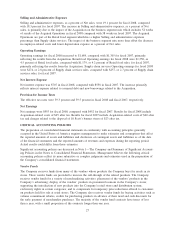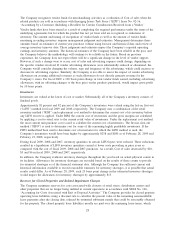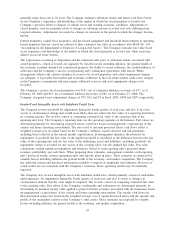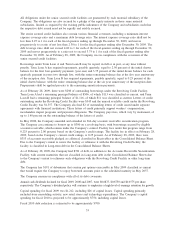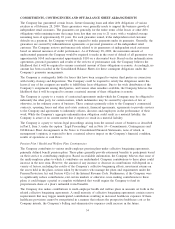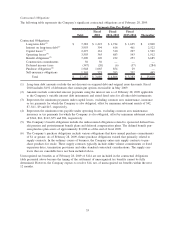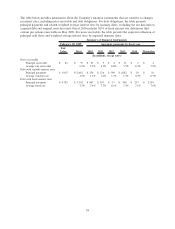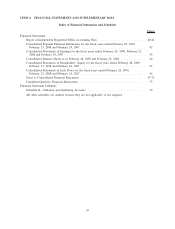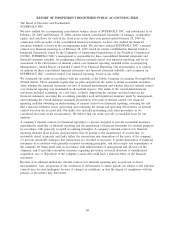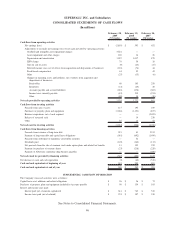Albertsons 2009 Annual Report Download - page 41
Download and view the complete annual report
Please find page 41 of the 2009 Albertsons annual report below. You can navigate through the pages in the report by either clicking on the pages listed below, or by using the keyword search tool below to find specific information within the annual report.requires the interest sold, as well as any interest retained, to be recorded at fair value with any gain or loss
recognized in earnings. SFAS No. 160 is effective for the Company’s fiscal year beginning March 1, 2009,
with early adoption prohibited. The adoption of SFAS No. 160 is not expected to have a material effect on the
Company’s consolidated financial statements.
In April 2008, the FASB approved FSP FAS 142-3, “Determination of the Useful Life of Intangible Assets.”
FSP FAS 142-3 amends the factors that should be considered in developing renewal or extension assumptions
used to determine the useful life of a recognized intangible asset under SFAS No. 142. FSP FAS 142-3 is
effective for the Company’s fiscal year beginning March 1, 2009 on a prospective basis to intangible assets
acquired on or after the effective date, with early adoption prohibited.
In May 2008, the FASB approved FSP APB 14-1, “Accounting for Convertible Debt Instruments That May Be
Settled in Cash upon Conversion (Including Partial Cash Settlement).” FSP APB 14-1 clarifies that convertible
debt instruments that may be settled in cash upon conversion (including partial cash settlement) are not
addressed by paragraph 12 of Accounting Principles Board (“APB”) Opinion No. 14, “Accounting for
Convertible Debt and Debt issued with Stock Purchase Warrants.” Additionally, FSP APB 14-1 specifies that
issuers of such instruments should separately account for the liability and equity components in a manner that
will reflect the entity’s nonconvertible debt borrowing rate when interest cost is recognized in subsequent
periods. FSP APB 14-1 is effective for the Company’s fiscal year beginning March 1, 2009. The adoption of
FSP APB 14-1 is not expected to have a material effect on the Company’s consolidated financial statements.
In June 2008, the FASB issued FSP EITF 03-6-1, “Determining Whether Instruments Granted in Share-Based
Payment Transactions Are Participating Securities.” FSP EITF 03-6-1 addresses whether instruments granted
in share-based payment transactions are participating securities prior to vesting and, therefore, need to be
included in computing earnings per share under the two-class method described in SFAS No. 128, “Earnings
Per Share.” FSP EITF 03-6-1 requires companies to treat unvested share-based payment awards that have non-
forfeitable rights to dividend or dividend equivalents as a separate class of securities in calculating earnings
per share. FSP EITF 03-6-1 will be effective for the Company’s fiscal year beginning March 1, 2009, with
early adoption prohibited. The adoption of FSP EITF 03-6-1 is not expected to have a material effect on the
Company’s consolidated financial statements.
In December 2008, the FASB issued FSP FAS 132(R)-1, “Employers’ Disclosures about Postretirement Benefit
Plan Assets.” FSP FAS 132(R)-1 provides additional guidance regarding disclosures about plan assets of
defined benefit pension or other postretirement plans. FSP FAS 132(R)-1 will be effective for the Company’s
fiscal year beginning March 1, 2009. The adoption of FSP FAS 132(R)-1 will result in enhanced disclosures,
but will not otherwise have an impact on the Company’s consolidated financial statements.
ITEM 7A. QUANTITATIVE AND QUALITATIVE DISCLOSURES ABOUT MARKET RISK
The Company is exposed to market pricing risk consisting of interest rate risk related to debt obligations
outstanding, its investment in notes receivable and, from time to time, derivatives employed to hedge interest
rate changes on variable and fixed rate debt. The Company does not use financial instruments or derivatives
for any trading or other speculative purposes.
The Company manages interest rate risk through the strategic use of fixed and variable rate debt and, to a
limited extent, derivative financial instruments. Variable interest rate debt (bank loans, industrial revenue bonds
and other variable interest rate debt) is utilized to help maintain liquidity and finance business operations.
Long-term debt with fixed interest rates is used to assist in managing debt maturities and to diversify sources
of debt capital.
The Company makes long-term loans to certain Supply chain customers and as such, holds notes receivable in
the normal course of business. The notes generally bear fixed interest rates negotiated with each retail
customer. The market value of the fixed rate notes is subject to change due to fluctuations in market interest
rates.
37


